Conservation Awards
Pieper Family Farms / Sioux View Farms, 2023
Lincoln-McPherson County
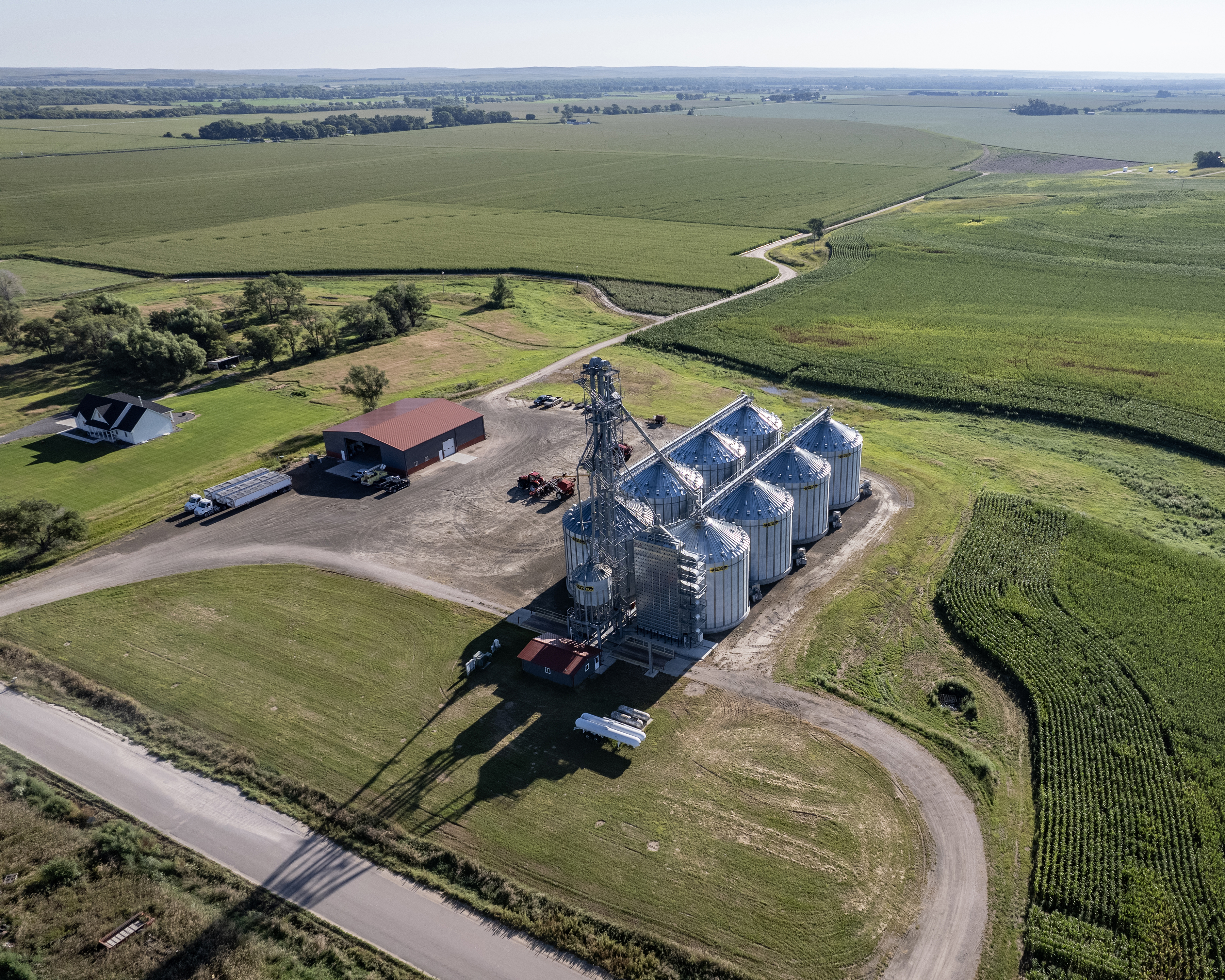
Pieper Family Farms / Sioux View Farms is a farming operation south of North Platte. Originally started by Kurt and David’s grandfather John Hahler, the farm is currently operated by the third generation, with the fourth generation including Brian Pieper and Cameron Kolling involved in the day-to-day operation of the farm, with a possible fifth generation already born. Kurt and David’s father Bernie moved from a southeast Iowa family farm to North Platte to farm with his father-in-law. When asked why he would ever leave Iowa for western Nebraska, his response was “a woman,” his wife, Mary. Together they grew the farm and a family of eleven children, and then handed the farming operation to the current generation.
Bernie and Mary moved to North Platte in 1953 and joined John and Mary Hahler to raise cattle, hogs, alfalfa, and corn. The operation grew through the late 1950’s and 1960’s and they began implementing conservation practices. Bernie began no-till farming in the mid 1960’s with the use of a buffalo no-till planter, and developed a hog operation in 1969 in which he used the affluent as fertilizer for the crops. He also converted ditch irrigation to gated pipe around the same time, and in the process a more efficient use of the water.
The 1970’s saw a significant development of pivot irrigation systems in the area, which were adapted by the farm. In 1976 Bernie, with the help of his sons, developed pivots with landlords in the Dickens area south of Hershey. Many different practices were employed to protect the sandy soil from wind erosion. The use of gypsum blocks, an early predecessor of present-day moisture monitors, were used on the farm in an effort to schedule irrigation and reduce the possibility of overwatering. More advanced moisture probes are still in use today.
The 1980’s were a trying time, in which the farm was not immune to the challenges due to loss of some ground, which caused a change in the operation of more ground becoming a custom farming operation to lessen the risk. During this time, pivots were converted from traditional high pressure to more efficient low-pressure systems, thus conserving water and energy. This period was also marked with the implementation of ridge-till planting, a practice that allowed more residue to remain on the surface to reduce the impact of wind erosion.
The 1990’s were marked by more efficiencies in water usage, driven mainly by the conversion of gravity irrigated fields being converted to pivot irrigation. This greatly reduced labor and water use in the ground located in the Platte River valley. This evolution continued into the early 2000’s.
In 2010, the farm made a transition from ridge-till to strip-till, another step that allowed even more residue to remain on the surface, thus preventing wind erosion and moisture evaporation from the soil. This practice also allowed the ability to apply fertilizer below ground in the root zone. Liquid fertilizer was used in this process for a few years, then in 2013 the strip-till systems were converted to apply dry fertilizer, increasing efficiency and lowering the risk of potential leaching. In 2013, cover crops were utilized on the farm. There had been a crop rotation of two years of corn followed by one year of soybeans, with cover crops planted following harvest of soybeans, which is a practice still in use today.
Pieper Family Farms / Sioux View Farms would like to thank the Twin Platte NRD for the conservation award, and also thank those who have helped throughout the farm production. They would also like to recognize a dedicated employee who has worked on the farm for the last 14 years, Miles Flock. The Pieper Family has had the privilege of dealing with the same loan officer throughout the years, Ted Klug. They have built great relationships with fuel, fertilizer, and equipment dealers within the ag community around the North Platte area, and none of this could have happened without the help of others.
Sadle Cattle Co, Chuck & Shari Flaming, 2017
Keith County
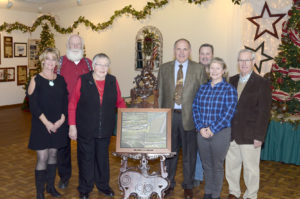
Shari Flaming’s grandfather, Bill Sadle, was born in North Platte. In his youth, he worked summers for Buffalo Bill on his “Wild West Show,” and in the late 1920’s he purchased land northwest of Paxton in the north valley. Shari’s father Byron Sadle, more commonly known as Bud, was raised on the homestead north of Paxton. This is where Shari grew up. Bud attended the University of NE and became a County Agent in Gosper County, then later returned to Paxton and bought the land from his dad and started to farm. Throughout the years, Bud purchased more land. In 1972 Chuck Flaming married sweet Shari Sadle. Upon their graduation from the University of NE, they came back to the farm with Bud and his wife Frances, where Chuck was an employee. In 1975 Bud decided to incorporate and the peration became Sadle Cattle Co. Chuck and Shari started to buy stock and eventually became the owners of Sadle Cattle Co. It was important for all the Sadle generations to improve the land and use the newest and best practices for soil conservation. Bud continued the practices, as well as Chuck and Shari, always working to make the land better. With their deep faith in God, they believe it was a blessing to enhance their property. It has taken many years to complete their conservation and restoration projects, and they feel nothing is more gratifying than to drive around in the evening and watch the baby Canada goslings swim in the restored wetlands, or watching the ducks and geese arrive in the fall as they migrate south.
In the 1950’s, Grandpa Bill and Grandma Edda Sadle, and Bud and Frances Sadle, received the Keith County Soil Conservationist Award.
Roric & Deb Paulman, 2012
Lincoln County
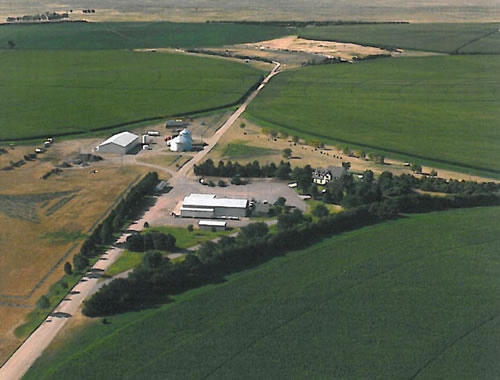
In 1985, Roric and Deb Paulman left Omaha and returned to the family farm in Sutherland, Nebraska. Shortly after they returned, Roric’s father unexpectedly passed away. They were a young couple with two babies, thrown into a whirlwind. Out of the fog emerged Paulman Farms; a custom farming operation. They have, with the help of many, grown their operation to look as it does today.
Conservation, you had to have your plan approved; “highly erodible,” “farmable wetlands,” all became part of your vocabulary if you were to qualify for program compliance. Habitat management captured acres. It was a natural fit to integrate the same kind of thinking to all of the acres. Recently, a good friend of the Paulman’s said, “good conservation will not happen without economic benefit”. With those words echoing in the background, many of the initiatives on their farm in water and land resource management can be quantified in energy and input cost savings.
Technology has led the way. GPS/RTK, variable rate irrigation, capacitance moisture probes, are just a few of the many tools. In an effort to get the word out beyond their fence lines, the Paulman’s have hosted demonstrations, meetings, and interaction with UNL students. The Nebraska Water Balance Alliance is an organization that has afforded them the opportunity to be involved at the state and federal level in decision making that will impact agriculture. This group provides a forum for discussion of new and innovative ideas for resource management. As a founding member, Roric believes that what has made this an exciting affiliation is the diversity of the NEWBA stakeholders and the collaborative efforts towards resource management for the benefit of all Nebraskans.
Deb and Roric would like to thank the many people who have spent countless hours planting and caring for the trees, shrubs, and grass. John Nelson always seemed to be giving Roric heck about weeds and mowing a strip so when he placed hand plants, he didn’t get sandbur and foxtail in his shoe laces, and Charles Grow out in the tree rows hand hoeing and raking the debris out of the conservation mulch. They amongst many are truly the reason the Paulman’s have been successful in their partnership with the Twin Platte NRD.
Gerry & Shari Kraus, 2011
Keith County
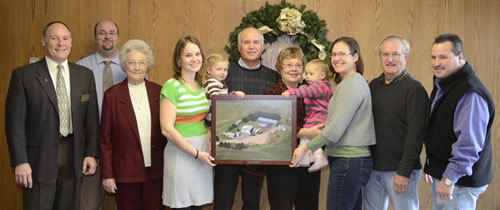
Gerard Kraus grew up on the family farm north of Madrid, NE. In 1971, after graduation from the University of NE at Omaha, Gerry returned to his Dad’s (John Kraus) farm in Perkins County. In 1973, Gerry married Shari Dodson of North Platte. They both had teaching degrees but continued to farm with his Dad until 1975, when Gerry took a job with Sisco Fertilizer, where he helped develop some of the first no-till corn crops in the area. In 1978, the family (now with two daughters), moved to a farm-job south of Paxton. In 1980, they had the opportunity to buy some dry-land cropland in Perkins County, which was then converted to center-pivot irrigation. In 1981, they moved four miles east of Ogallala and rented farm land from Robert Lute.
They have remained on the Lute Homestead since, acquiring more land to rent and purchase. The family continued to grow with two more daughters. Shari has helped by being the bookkeeper, and also working in the field at critical times. In 1981, the family began planting trees on the home-site and used no-till farming practices. Gerry raised corn and wheat in a three year rotation before adding millet, sunflowers, popcorn, and soybeans. Eventually they completely dropped the “fallow-period” and went entirely to “continuous-crop” farming. The end result of these conservation practices has been a reduction in both wind and water erosion, with an increase in the overall health of the soil, not to mention a more profitable way of farming.
Their center pivots have also been converted to low-pressure which have increased efficiency and conserved water, and the corners of the pivots have been planted with trees. Gerry and Shari currently rent from five different landowners and are grateful to be able to pursue innovative conservation farming practices which have been beneficial towards the land which they farm.
Gerry and Shari’s daughters have all graduated from college and are working professionally. Denise & husband, Jim Ryan, live in Chicago, IL and have an infant son, Aaron. Laura & husband, Tim Moulton, Lincoln, NE are parents of Katie (4) and Jessica (18 months). Lisa resides in Washington, DC and works in U.S. State Department for Bureau of Education and Cultural Affairs. Amy, an Architect, is working in her profession in Omaha, NE. Gerry and Shari are active members of St. Luke’s Catholic Church and volunteers to Ogallala’s Blood Mobile, Food Pantry, and Habitat for Humanity.
James Fleecs Family 2009
Lincoln County
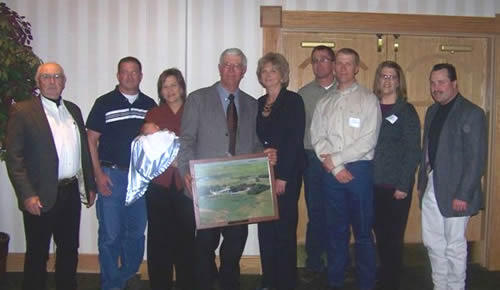
After returning home from the service in 1970, Jim Fleecs began farming and ranching with his brother, Lloyd. Jim started his own cow/calf and yearling operation in 1987. Through the years, the ranch has added and upgraded multiple livestock watering systems and cross fenced pastures. All of this has enabled the ranch to run larger numbers of cattle for shorter time frames as part of a rotational grazing plan, which has led to improved range conditions, plant diversity, and additional wildlife habitat.
The Birdwood Creek has been fenced off, along with two spring fed ponds that were both fenced off and renovated for water quality and wildlife. Trees for windbreaks were planted to provide protection for livestock, while also providing habitat for wildlife.
Center pivots have been converted to low pressure sprinkler packages, which has increased efficiency and conserved water. Jim has three children: Jill and her husband Dan Vaughn and their children Kate and Ty; Dan; Tracy and her husband Tim Berntson and their children Anna and Max; and special friend Sally, all of Hershey. Jim is a member of the Hershey American Legion and is a fireboard member.
Paul & Janet heinrich, 2008
Keith County
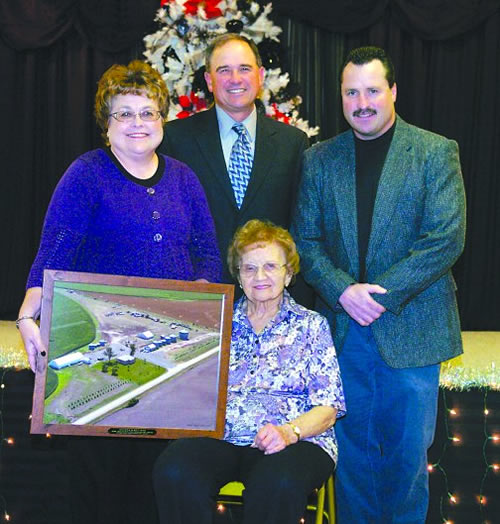
Paul and Janet Heinrich began their farming career upon returning home from college in 1978. They now reside in the family home, south of Paxton, built by Paul’s parents in 1950. The Heinrich family currently raises corn, soybeans, and wheat, but has raised crops as diverse as alfalfa, sunflowers, popcorn, kidney beans, pinto beans, milo, barley, rye, and millet. While greatly honored to receive this award, much of the credit goes to Paul’s parents, Benjamin and Ruby, as they made efforts to be good stewards of the land by practicing methods of conservation that available equipment and technology would allow.
Being typical wheat-fallow farmers of the time, every effort was made to retain as much residue as possible on fragile ground, realizing the benefits received. Recognizing that the Noble blade plow was a significant improvement in equipment for this practice, its use was quickly incorporated into the operation. Later, after Paul and Janet returned to the farm, they were among the first in this area to experiment with and adopt the practice of planting ecofallow dryland corn. They have since incorporated ecofallow farming methods in raising all their crops.
After the death of Janet’s father, Virgil Anderson, in 1981 and Paul’s father in 1983, Paul and Janet became tenants for both family farms. They have also rented and still rent from other family members. Both are very grateful for the allowance by their landlords to pursue experimenting with and adopting innovative conservation farming practices which have been mutually beneficial. Beginning in the 1980’s, the operation has evolved from early attempts at being entirely no-till on dryland and ridge planting on irrigation, to now being mostly no-till and strip till with some minimum tillage as needed. Early on they recognized the value of strip tillage and were quick to adopt this method. They have planted some very fragile ground to grass, and other land is in the application process for development of wildlife habitat. In the past few years, trees and shrubs have been planted for erosion protection and wildlife habitat.
Paul and Janet are the proud parents of two children. Their daughter Sara lives in Kansas City, Missouri, and their son Jeff, his wife Lynn, and their daughter Hannah live in Lincoln. Paul and Janet are life members of Trinity Evangelical Lutheran Church in Paxton, and have been active in their community’s activities and organizations.
Don & Marcia COlvin, 2006
Lincoln County
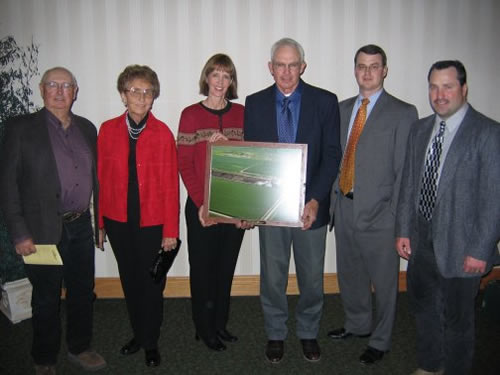
In the spring of 1975, Don and Marcia Colvin began their farming operation in the Platte River Valley area, located five miles west and two miles north of North Platte, Nebraska. In 1981, they purchased the farm where they now reside. The primary crops of their farming operation include irrigated corn and alfalfa. Conventional farming practices have been replaced over the years with minimum and no-till methods.
Land leveling, conversion to gated pipe, and use of surge valves all have improved and made flood irrigation to their property more efficient for several years. In 1997, the Colvin’s began converting flood irrigated ground to center pivot, which increased efficiency and has conserved water. Trees for windbreaks were planted to provide protection near calving areas and the cattle feedlots. These windbreaks help prevent wind erosion, while also providing habitat for wildlife. Don was involved in the formation of the Nebraska Water Users in 1991.
This organization raised awareness of water issues in Nebraska, and has helped inform the public of the importance of water and irrigation in Nebraska. Don and Marcia are the parents of three children: Rebecca and her husband Jeremy Murphy of Lincoln; Laura of Lincoln; and David of North Platte. Don and Marcia are active members of Beautiful Savior Lutheran Church in North Platte, and enjoy participating in school and community activities.
Most Farms, 2005
Keith County
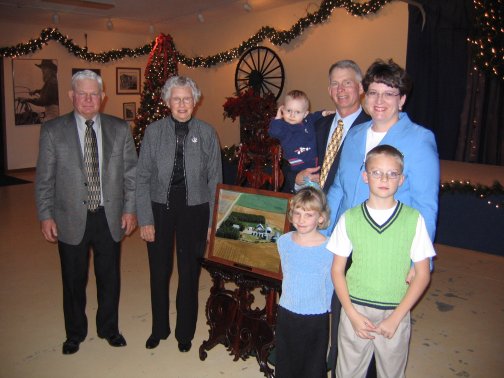
In 1950 following his high school graduation, Don Most began his career of farming and ranching on the family farm southeast of Ogallala. In 1951 after the death of his father, Don took over the farm. In 1955 he purchased the home place and married Anita Gengenbach, and they have resided there ever since. Two children were born to Don and Anita; Melanie and Samuel. Sam joined the family farm in 1982 following his graduation from the University of Nebraska-Lincoln with a degree in Agricultural Economics.
In 1953, Don hand planted a grove of cedar trees on the south side of the farmstead. A second grove of cedar trees was planted north of the farmstead in 1965 and 1966. Irrigation was introduced to the farm in 1974 with the addition of a center pivot. There are now three center pivots on the farm. A new grove of cedar trees was planted by hand on Sam’s place in 1980. It was expanded in 1990 by machine. The windbreak at Sam’s was enhanced by a drip irrigation system and is very valuable in the spring during calving. Also in 1990 another grove was planted on the north side of an irrigated circle. The farm is diversified growing wheat, corn, popcorn, dry edible beans, soybeans, alfalfa, in addition to a small cow-calf operation. No-till dryland corn has been planted for many years conserving moisture.
Since 2004, a strip-till machine has been utilized to plant the irrigated crops as well. Many miles of terraces have been built and re-done over the years to protect the erodible land. There are currently 150 acres of CRP land, with additional acres to be entered in 2006.
Sam and his wife Jody have three children; Micah, Amanda, and Caleb. Don and Anita’s daughter, Melanie, lives in Syracuse, Nebraska. The Most family are active members of St. John’s Lutheran Church southeast of Ogallala.
Larry & Phyllis Kracman, 2003
Lincoln County
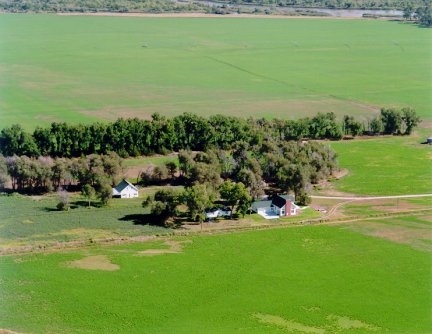
Larry and Phyllis Kracman were married in 1966 and lived in Gothenburg, Nebraska. At that time, Larry’s lifelong practices of good conservation really began to take hold. Phyllis was a schoolteacher north of Gothenburg, and Larry farmed some of the family ground. In 1967 Larry and Phyllis started Kracman Fertilizer Inc. at Brady. This well known fertilizer business was a labor of love for Larry and Phyllis. They operated the business for 23 years, with Larry as the owner/manager, and Phyllis as the bookkeeper. In 1980 they purchased their home north of Brady, where they planted hundreds of trees. At this time, Larry realized that he would not live there forever, but the trees would be there long after he was gone.
As the children grew up on the farm, they developed a sense of good conservation as their parents actively practiced it. While operating Kracman Fertilizer Inc., Larry and Phyllis purchased several tracts of land. Larry and Phyllis have implemented many conservation measures on this land. A neighbor noted “everything they’ve ever touched, they’ve improved”. Through conservation measures such as converting flood irrigation ground to pivots and installing several surge irrigation systems, Larry has been able to conserve irrigation water, reduce erosion, and save energy.
Larry also utilized a conservation crop rotation that is 100% ridge till on continuous corn or alfalfa. Larry has also been willing to try some new conservation programs to benefit the environment. Larry participated in a demonstration project of seeding a grass buffer around an irrigation well. Larry and Phyllis were also one of the first participants in Continuous CRP, and planted 510 trees on a farm south of North Platte.
Other conservation practices Larry and Phyllis have implemented over the years include 88 acres of grass seeding, one irrigation recovery system, one livestock watering facility, numerous surge systems, and irrigation water management (on all irrigated cropland acres). Larry and Phyllis have been very involved in the community in which they reside, and also in Lincoln County. Larry was on the Brady town board and was eventually the mayor of Brady for approximately six years. During his term as mayor, Larry was instrumental in getting several dams around Brady built that would prevent another flood like the one that occurred in 1973.
Larry was one of the founding members of the Lincoln County Planning Commission. He served on this board for 25 years, and just recently resigned. Larry is very proud of all the accomplishments of the Commission. Larry was also instrumental in expanding the Central Public Power and Irrigation District to include a director from Lincoln, Keith, and Dawson Counties.
Larry also worked with the local legislators to see that input came from these counties as well. Larry then served on the board of directors for four and one-half years. Larry and Phyllis are members of the Brady Methodist Church, where both have been Sunday schoolteachers, and also the Evangelical Free Church in North Platte. Larry and Phyllis have three children: Kim and spouse Chris Skinner of Princeton, NJ; Krista and spouse Kenny Galloway and their daughter Molly of Seattle, WA; and David Kracman of Sacramento, CA.
Grapes Farms, 2002
Keith County
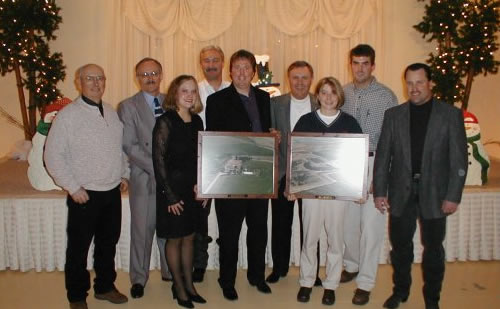
In 1934, Ivan Grapes and his brother, Bill Grapes, moved to this part of the country. In those first years living on a farm 15 miles northwest of Brule where the north table dropped down to the North Platte River, there were very few conservation practices being utilized. That changed with the drought of the thirties, and the need to stop the north and west winds on one of the highest elevation points in Keith County. After only one year of surviving the elements, Ivan’s brother Bill and his wife left for California. Ivan remained on the farm and began planting trees to provide shelter. He was on his own until 1938 when he married Tiny. Together, Ivan and Tiny continued to plant more trees for protection against abrasive storms. In both 1956 and 1957, Ivan and his son Ron planted several more windbreaks with bareroot trees, utilizing a Tree Conservation Program with the Halsey National Forest in Halsey, Nebraska. The trees were all hand plants, with replacement trees being taken from the pasture.
Todd R. Grapes, the son of Ron and Judy Grapes, is the third generation family member to continue in the daily farm and ranch operation. The Grapes Family has continued with the windbreaks at the farm headquarters, now located eight miles south of the original homestead. The first windbreaks started by Ivan and Tiny on the old homestead have been enhanced and extended in order to provide protection for future conservation activities. Currently, the only difference is now the trees are machine planted, and water conservation mulch is installed rather than planted by hand. However, the Twin Platte Natural Resources District annually supplies the Grapes’ with “farmer hand plants” to remind them of the “Good Old Days”.
Early on, Ivan began rotating livestock between two pastures, which has currently grown into a cross-fenced rotational grazing system. Several water tanks have also been added to better utilize all areas of the pastures. Several miles of terraces have been installed over the years for erosion control measures. The practices of no-till and minimum-till farming are being used to help conserve top soil and moisture.
Each year the Grapes Family plants trees and will continue to do so for many years to come. Todd is glad his family installed these conservation practices because they are really meant to benefit the next generation. Todd also commented that everything and everyone will benefit from respecting, conserving, protecting, and enhancing the land that creates a great place to live.
Richard & Elaine Bode, 2000
Lincoln County
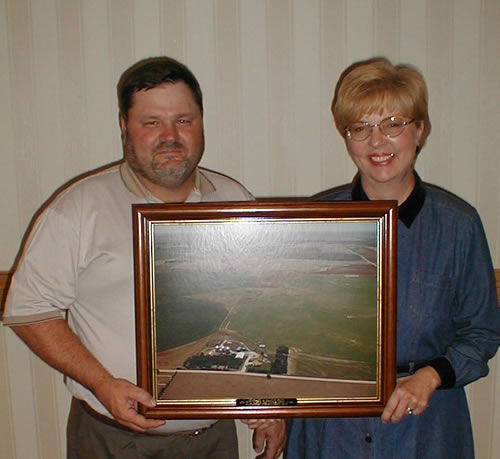
In April of 1978, Richard and Elaine Bode began their farming operation located three miles south and three miles west of Hershey, in partnership with Elaine’s parents, Orval and Frieda Einspahr. Orval and Frieda retired in 1984. Elaine’s grandparents, Fred and Ruby Hackbarth, had originally owned the land. Rick farmed with his family and worked as a well driller for Staska Well Drilling Co. at Albion, Nebraska, before he and Elaine moved to the Hershey area.
Irrigated and dryland corn, wheat, and irrigated soybeans are the crops that are grown. Minimum and no-till farming practices have replaced conventional farming practices to maintain cover, conserve moisture, and to prevent soil erosion. Two years ago, the Bodes’ discontinued the use of a wheat, ecofallow corn, and summer fallow rotation, and began to use a continuous crop rotation of wheat and short-season corn.
Approximately 23,000 feet of terraces have been installed to treat the highly erodible land. The Bodes planted 1,900 red cedar, juniper, cottonwood, honeylocust, and Austrian pine trees to provide windbreak protection.
Rick and Elaine have three children: Jason of Long Island, NY; Jennifer of Hershey; and Josh, a sophomore at UNL. Rick and Elaine are active in school, church, and community programs.
Harms Inc, 1999
Keith County
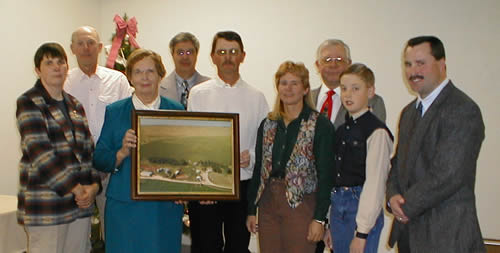
The Harms Family came to Brule, Nebraska in 1909. The youngest son of the Harms family, Evert, farmed north of Brule. Evert entered into a rental agreement with his son Milan to farm the land and to share rangeland from 1955 until Evert’s death in 1960.
The farm was incorporated and named Harms Inc. Milan then became a full time partner with his mother Margaret, until purchasing Harms Inc. in the late 1970’s.
Both Margaret and Milan passed away in 1997. Harms Inc. is now owned by Jo Anne Harms and their five children: Patty, Jean, Amy, Brad, and Faye.
Late in the 1950’s a heavy spring snow fell, creating a rapid snow melt and flooding. The Harms home in town was surrounded by flood waters.
Around this time, the “Brule Watershed” was organized by area farmers and Brule citizens.
In 1961, the first small dam was constructed north of Brule in Harms rangeland by Beal Enterprises. The main watershed dam was constructed in 1969 north of the farm, and waterways were built on the Harms land east of Brule to provide drainage to the South Platte River.
Beal Enterprises drilled an irrigation well and Harms Inc. furnished pipe as a water source needed for the dam construction. Ten million gallons of water was used to “presettle” the ground on which the dam was being built.
The Brule Watershed Dam construction project was designed and supervised by the USDA Soil Conservation Service (Natural Resources Conservation Service).
Over the years, more flooding problems have occurred in the town of Brule. In 1994, the Twin Platte Natural Resources District and the Natural Resources Conservation Service Engineers cooperated with Milan to find a cost effective way to correct the flooding problems. Two small dams were constructed on Harms rangeland, and highly erodible land was terraced and seeded to native grasses to help control water run-off.
A total of 389 acres of highly erodible land was enrolled by Harms into the Conservation Reserve Program (CRP) in 1996. Native grasses were planted in the spring and fall of 1996. Fences were constructed to exclude livestock.
A two day rain event in September, 1996 caused a considerable amount of flood water to drain from north and west of Brule. The county road east of Harms farm was nearly washed out. Flood water drained into the large dam north of Harms, but was contained in the reservoir. The over-flow drains of the smaller dams drained for two and a half days. The flood water was contained in the road ditch waterway, and prevented flooding at the Brule Cemetery.
In the fall of 1998, the Union Pacific Railroad, the Twin Platte NRD, and the Natural Resources Conservation Service cooperated on a project to remove silt from beneath the railroad bridge east of Brule. The bridge is part of the outfall channel, which was constructed to allow water to flow to the South Platte River.
The County and the Nebraska Department of Roads continue to remove any excess silt in their structures in conjunction with the Brule Watershed and the outfall channel.
In 1997, Milan and his mother Margaret donated land adjoining the Brule Cemetery to the Cemetery Association to allow for future expansion. Improvements on the donated land of trees and waterways around the perimeter provide additional protection for the cemetery. Funds given in memory of Milan and Margaret allowed for two rows of evergreen trees and installation of a fence. The Twin Platte Natural Resources District cost-shared on the trees. All work was supervised by the Brule Lions Club.
Brad and April Harms and Stan and Ken Rhoades have leased all of Jo Anne’s cropland. Brad and April use minimum tillage in their corn and wheat crop rotation. The Harms rangeland is in a rotational-use program to allow for proper grazing. Jo Anne still has a cow herd that is cared for by Brad and April.
The Harms family cooperates with the Natural Resources Conservation Service to maintain the dams in the rangeland and CRP land. The Twin Platte Natural Resources District provides the maintenance for the Watershed Dam north of Harms farm.
Jo Anne resides on the family farm and is active in the management of the operation. All of the Harms children are involved in agriculture. They all enjoy riding horses for work and for pleasure.
Jo Anne and her family gratefully accept this award with much appreciation on behalf of the Harms family, both living and deceased.
Geisert Family Farm, 1997
Keith County
Soil conservation has always been a big part of this farm operation. Even though primitive efforts were made in the early years, improvements began with some of the first terrraces in Keith County under the newly formed Soil Conservation District. These terraces, which have been built with a John Deere A and a two bottom plow, were seeded to grass and are still in existence today. Currently, 20 miles of terraces have been installed and rebuilt at various times.
Three flood control dams and two miles of grassed waterways have been completed. Since 1995, underground outlets serving 22,000 feet of terraces under center pivot irrigation have been installed. All pivot irrigation land is under a conservation tillage system and irrigation water manaagement program. Proper grazing use is always practiced on all grazing land supporting the cattle operation. Windbreak protection has been an important part of the farmstead. Currently, there are 1,200 mature trees protecting the farmstead.
Melvin & Faye Bayne, 1997
Lincoln County
Currently, the farming operation consists of 460 total acres. The cropland includes 350 acres of irrigated corn and 100 acres of irrigated alfalfa. Conservation work, which has been or is being utilized, includes 350 acres of minimum tillage, with 450 acres of proper treatment of cropland.
Throughout the course of many years, Melvin has also provided a service of interseeding native grasses on thousands of acres of rangeland in the Twin Platte Natural Resources District. Melvin commented that their conservation efforts, as well as their business efforts, were possible because of the support from his family and friends, and the involvement of his son, Maurice.
Back to Awards Home Page